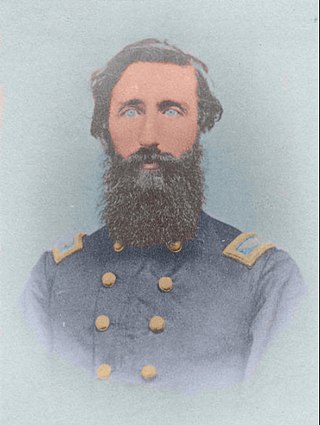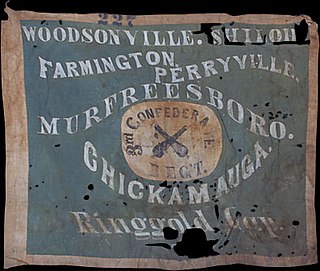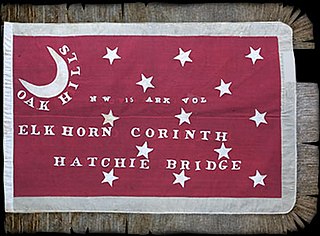The Battle of Cotton Plant also known as Action at Hill's Plantation or Action at Cache River or Action at Round Hill was fought during the American Civil War in Woodruff County, Arkansas. Frustrated in its attempt to march to Little Rock by a lack of supplies, the Union Army of the Southwest under the command of Samuel Ryan Curtis moved south down the White River. Curtis's army encountered a Confederate force led by Albert Rust on the east bank of the Cache River near Cotton Plant. Rust was only able to bring two Texas cavalry regiments into action. These horsemen attacked the Federal advance guard under Charles Edward Hovey, but after a spirited fight, Union reinforcements arrived and drove off the Texans. Rust's force made a disorderly retreat and Curtis's army was able to march south to Clarendon before veering east to occupy Helena on the Mississippi River.

The Battle of St. Charles was fought on June 17, 1862, at St. Charles, Arkansas, during the American Civil War. Earlier in 1862, a Union Army force commanded by Major General Samuel R. Curtis moved against Little Rock, Arkansas, but became bogged down in the Batesville area due to lack of supplies. The Union leadership decided to send a naval force from Memphis, Tennessee, up the White River to resupply Curtis's men. Major General Thomas C. Hindman, the Confederate commander in Arkansas, had fortifications constructed near St. Charles to stop the Union movement. Two artillery positions were built, and three ships, including CSS Maurepas, were scuttled to obstruct the river.

During the American Civil War, Arkansas was a Confederate state, though it had initially voted to remain in the Union. Following the capture of Fort Sumter in April 1861, Abraham Lincoln called for troops from every Union state to put down the rebellion, and Arkansas along with several other southern states seceded. For the rest of the civil war, Arkansas played a major role in controlling the Mississippi River, a major waterway.

The 3rd Illinois Cavalry Regiment was a cavalry regiment that served in the Union Army during the American Civil War. It fought at such battles as Pea Ridge, Sherman's Yazoo campaign, the battle of Port Gibson, and the siege of Vicksburg.

The 33rd Illinois Infantry Regiment was an infantry regiment from Illinois that served in the Union Army during the American Civil War. A number of the soldiers were college students and graduates, and for a time the regiment included a 17-piece band. The unit fought at Fredericktown in 1861, Cotton Plant in 1862, the Vicksburg campaign and Fort Esperanza in 1863, and at Spanish Fort in 1865. The original enlistees were mustered out in October 1864 while the veterans and recruits were mustered out in December 1865.

The 1st Regiment Arkansas Volunteer Infantry (1863–1865) was an infantry regiment that served in the Union Army during the American Civil War. Although Arkansas joined the Confederate States of America in 1861, not all of its citizens supported secession. Arkansas formed some 48 infantry regiments to serve in the Confederate Army, but also formed another 11 regiments that served in the Union Army.

The 1st Arkansas Cavalry Regiment (1862–1865) was a cavalry regiment from the state of Arkansas that served in the Union Army during the American Civil War.

James M. Johnson was an American soldier and Arkansas politician. During the American Civil War he was a southern unionist and officer in the Union Army; serving as an aide to multiple generals and later commanded the 1st Arkansas Infantry Regiment (Union), eventually being made a brevet brigadier general. Following the war he would become the 2nd Lieutenant-Governor of Arkansas and later the 10th Secretary of State of Arkansas. During his tenure in Arkansas politics Johnson formed his own faction in the Arkansas Republican Party, which went against the policies of Governor Powell Clayton. The two men later tried to impeach the other on trumped up charges. Though Johnson was never convicted he lost his political support and left politics.

The units of the Arkansas Militia in the Civil War to which the current Arkansas National Guard has a connection include the Arkansas State Militia, Home Guard, and State Troop regiments raised by the State of Arkansas. Like most of the United States, Arkansas had an organized militia system before the American Civil War. State law required military service of most male inhabitants of a certain age. Following the War with Mexico, the Arkansas militia experienced a decline, but as sectional frictions between the north and south began to build in the late 1850s the militia experienced a revival. By 1860 the state's militia consisted of 62 regiments divided into eight brigades, which comprised an eastern division and a western division. New regiments were added as the militia organization developed. Additionally, many counties and cities raised uniformed volunteer companies, which drilled more often and were better equipped than the un-uniformed militia. These volunteer companies were instrumental in the seizure of federal installations at Little Rock and Fort Smith, beginning in February 1861.
The 36th Arkansas Infantry Regiment (1862–1865) was a Confederate Army regiment during the American Civil War. Originally known as McRea's Emergency Regiment, had been organized as the 28th Arkansas Infantry Regiment. After the Battle of Prairie Grove, the regiment was reorganized and designated the 36th Arkansas Infantry Regiment. The regiment is also referred to as the 2nd Trans-Mississippi Infantry Regiment, Glenn's Regiment, and Davie's Regiment.

The 3rd Arkansas Field Battery (1860–1865) was a Confederate Army artillery battery from Pulaski County, Arkansas, during the American Civil War. The battery is also known as the Totten Light Artillery, Pulaski Light Artillery, the Weaver Light Artillery, Woodruff's Battery, and Marshall's Battery. The battery originated as a pre-war Militia company, initially enrolled in state service. After the Battle of Wilson's Creek, the battery was released from state service and eventually reorganized for Confederate Service. The battery provided the initial training for the leaders of numerous other Arkansas artillery batteries during the Civil War. The battery spent its entire service in the Department of the Trans-Mississippi.

The 18th Arkansas Infantry (Marmaduke's) (1861–1865) was a Confederate Army infantry regiment during the American Civil War. The unit was also briefly identified as the 1st Arkansas Infantry Battalion. The unit was most often referred to as the 3rd Confederate Infantry Regiment. The designation "Confederate Infantry Regiment" was intended to convey the difference between Provisional Confederate Army units and Regular Confederate Army Units, with Provisional units being those regiments who received a state designation such as "XX Arkansas Infantry Regiment". In practice, the designation was most often utilized when Regiments were assembled utilizing companies from more than one Confederate state. The "3rd Confederate Infantry Regiment" is occasionally misidentified as the 3rd Arkansas Infantry Regiment commanded by Colonel Van H. Manning.

The 15th Arkansas Infantry Regiment, also known as the "Northwest regiment", was an infantry formation of the Confederate States Army during the American Civil War. It was originally formed as the 3rd Arkansas Infantry Battalion. After receiving the requisite ten companies, the battaltion was redesignated as the 21st Arkansas Infantry Regiment. Upon discovery that there was already another "21st Arkansas," the Northwest Regiment was again redesignated as the 15th Arkansas Infantry Regiment. This was the third Arkansas regiment to bear the designation "15th Arkansas." The others are Johnson's and Josey's Arkansas infantry regiments. Members of the Northwest Regiment fought both west and east of the Mississippi River before participating in the Vicksburg campaign, surrendering at Vicksburg in July 1863. After being paroled and exchanged, the regiment was consolidated with other state units to form the 1st Consolidated Arkansas Infantry Regiment.
The 30th Arkansas Infantry (1862–1865) was a Confederate Army infantry regiment during the American Civil War. This regiment was also called the 5th Arkansas Cavalry, the 5th Trans-Mississippi Regiment or 39th Regiment after April, 1863. This regiment was converted to mounted infantry for Price's Missouri Expedition in 1864 and was known as Rogan's Arkansas Cavalry. There were two regiments officially designated as the 30th Arkansas Infantry. The other 30th Arkansas served east of the Mississippi River and was redesignated as the 25th Arkansas Infantry.
The 1st Arkansas Infantry (1861) was a Confederate Army infantry regiment during the American Civil War. The unit was composed mainly of militia units called to service by Colonel Solon F. Borland in response to an anticipated invasion of Northeast Arkansas in the fall of 1861.

The 22nd Arkansas Infantry Regiment was a Confederate Army infantry regiment during the American Civil War (1862–1865). This regiment was originally organized as the 17th Arkansas Infantry Regiment, reorganized after the battle of Pea Ridge as 1st Regiment, Northwest Division, Trans-Mississippi Department, or Rector's War Regiment, redesignated as the 35th Arkansas in the summer of 1862, and reorganized and redesignated as the 22nd Arkansas following the Battle of Prairie Grove. The unit was also sometimes referred to as, King's Arkansas Infantry or McCord's Arkansas Infantry. This was the second regiment to be officially designated as the 22nd Arkansas. The first was mustered in at DeValls Bluff, Arkansas, on April 9, 1862, and later reorganized as the 20th Arkansas Infantry Regiment.
The 39th Arkansas Infantry Regiment or the 6th Trans-Mississippi Rifle Regiment was an infantry formation of the Confederate States Army in the Trans-Mississippi Theater of the American Civil War. The regiment was successively commanded by Colonels Albert W. Johnson, Alexander T. Hawthorn, John B. Cocke, and Lieutenant-Colonel Cadwallader Polk.
The Brown's Arkansas Artillery Battery (1862–1863) was a Confederate Army artillery battery during the American Civil War. Also known as: the Newton Artillery. The battery operated in the Confederate Department of the Trans-Mississippi for its entire existence.
The 11th Missouri Infantry Regiment (also known as Hunter's Missouri Infantry Regiment and 8th Missouri Infantry Regiment (Burns')) was an infantry regiment that served in the Confederate States Army during the American Civil War. The unit was mustered into Confederate service on August 31, 1862, although many of the men recruited for the regiment had already seen action at the Battle of Lone Jack. On December 7, the regiment fought at the Battle of Prairie Grove, where the regiment helped defeat Colonel William A. Weer's brigade. Prairie Grove was a Confederate defeat, and the 11th Missouri Infantry retreated into southern Arkansas. Later, the unit began moving against the garrison of Helena, Arkansas. On July 4, 1863, the regiment penetrated the Union works at the Battle of Helena, although its brigade was soon isolated and defeated.













